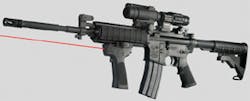While at SHOT Show in the LaserMax booth I saw a rifle accessory I didn't remember seeing before. When I inquired I found out that it was the new Colt Grip Laser (CGL). The unit is pistol-grip shaped, incorporates an LED light, a laser aiming device and attaches via a quick release lever to any picatinny rail system. I submitted my request for a test unit and it arrived a couple weeks later. Since that time it's been mounted on an AR-15, a paintball gun, an airsoft gun and been used as a stand-alone light/laser unit. Here's how it's done so far.
First off, let's recognize that this single unit combines several accessories that are commonly mounted on working rifles today.
- A vertical fore-grip
- An aiming laser
- A light
The variations commonly found in #2 is that it is either green or red. While there is no debate about whether or not green is more visible in daylight than red, there is a huge preference debate over whether or not a lethal-force laser indicator should be any other color than red.
The variations commonly found in #3 are a little bit more wide spread. The light can either be bright enough to be "tactical" - that is for target identification and engagement at distances usually qualified to for CQB use (150 yards is my assumption here), and such a light would have to throw 150 lumens or more that distance. The light could also be used for much closer work and not as much for target identification. "Navigation" lights need not be as bright and LEDs have dominated this use of late. LEDs can be had in a variety of colors. As you can see, the Colt Grip Laser offers LED colors of red, white or blue.
For the record: my test unit has white LEDs and a red laser.
Mounting the unit proved easy thanks to the quick-throw locking-lever picatiny mount. I mean, you open it, put it where you want it and lock the lever over. Minor adjustments may be necessary to the set screw dependent on your picatiny rail manufacturer (they can be several thousandths of an inch different in width) but aside from that mounting is place and lock in. On the back of the unit is a selector lever that allows you to choose:
- Everything on the unit is turned off / disabled
- The LEDs are selected
- The laser steady on is selected
- The laser blinking is selected
If the selector switch is in a position that selects the light or laser then touch pressure on the button on the front of the grip (just under your index finger as your grasp it) will activate that which you've selected. If you push harder on the button it will click and lock on the selected light/laser. Another push deactivates it.
The laser aiming device is adjustable for windage and elevation by using the provided allen wrench. The laser emitter is centered in the unit so that when the unit is mounted the laser is almost directly (it may be incrementally off) under the bore axis. This is preferable to having the laser off-set to one side or the other by as much as two inches using some other units. Think about it: you zero it for a particular distance. In CQB engagement distances if the laser is off up or down a few inches that still means you hit your target. At longer ranges, even if it's off as much as four inches low, you'll still hit along the centerline of your target. Lasers off-set to the side are off not only on elevation but also on windage - it's a two axis adjustment you have to try to figure out on the fly. I might be that good but I don't like to think that hard if I don't have it - especially if I'm in a hurry to engage a bad guy.
The final selling point for me is that the unit runs on two AA batteries. As one Chief of Police I know put it: "In an crisis situation I may not be able to find those special CR123 3volt lithium things. Double As can be found in every corner store and gas station." What the Chief added on later was the observation that the cost of AAs is far less than lithiums, and since - in this case - we're talking about powering an LED unit and a laser unit, the power draw isn't huge.
So, I mounted my unit, zeroed it and did some dry runs with it. The dry runs were interior searches in no-light situations. The LED light worked well for navigation and in room-size environments served well enough. On the range I fired about 50 rounds, dismounted the unit, threw it around some, remounted it and fired another 50. I didn't observe that the zero had changed drastically and certainly not enough to be of concern in CQB combat situations at those expected distances.
When I was done with range testing I mounted the unit on my son's paintball gun and let him run some drills with it. He's 12 years old and within minutes was manipulating the light / laser selector switch without much thought. His larger challenge is using the unit mindful that it can give away his position if he's not careful.
Off the paintball gun and onto the airsoft M4 the unit went. We rezeroed it and shredded some paper targets in the backyard using the laser aiming device.
Were the paintball gun and airsoft gun necessary testing? Nope - but they were fun.
All in all I'm pretty impressed with the unit. Retail price is $399 on the LaserMax website (linked below). I found one priced at $373 after a Google search so do your homework. It's a handy and functional unit if the combined accessories suit your needs.
Stay Safe.
About the Author
Lt. Frank Borelli (ret), Editorial Director
Editorial Director
Lt. Frank Borelli is the Editorial Director for the Officer Media Group. Frank brings 20+ years of writing and editing experience in addition to 40 years of law enforcement operations, administration and training experience to the team.
Frank has had numerous books published which are available on Amazon.com, BarnesAndNoble.com, and other major retail outlets.
If you have any comments or questions, you can contact him via email at [email protected].

